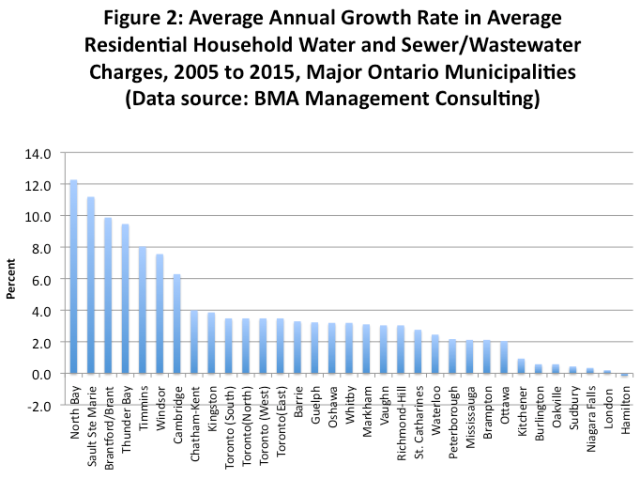Municipal finances in Ontario—growing water charges, too
While there is a growing property tax burden in Ontario, what’s often left out of the discussion is the parallel rise in separate water and sewer/wastewater charges. The BMA Management Consulting Group’s annual municipal studies present data on average residential household water and sewer charges. These charges have actually grown at a faster annual rate than residential property taxes since 2005.
The two charts below present the residential average household water and wastewater charges for 33 major Ontario communities in 2015 and their average annual growth rates between 2005 and 2015. The charge ranges from a low of $406 in Mississauga and Brampton respectively to a high of $1,224 in Brant with the average for these 33 communities at $800. The top five communities for average household water charges are Brant, North Bay, Windsor, Thunder Bay and Kingston.

As for the growth rates, the average annual increase for water and wastewater charges across these communities between 2005 and 2015 comes in at 3.8 per cent. The steepest annual increases in these charges have been have been in North Bay and Sault Ste. Marie at 12.3 and 11.2 per cent respectively. Indeed, the growth rates have ranged from a high of 12.3 per cent in North Bay to a low of -0.1 per cent in Hamilton.

Only four out of these 33 communities have seen increases in their water and sewer charges grow more slowly than Ontario’s real per capita GDP, a broad measure of average income growth (Sudbury, Niagara Falls, London and Hamilton). Moreover, recent growth rates have been particularly pronounced in North Bay, Sault Ste. Marie, Brantford/Brant, Thunder Bay, Timmins, Windsor and Cambridge.
Water and sewer/wastewater charges have been rising rapidly as many communities upgrade their water systems after decades of neglect. One of the justifications for the rising rates is to promote environmental responsibility and water conservation.
However, the problem is that much of a water bill these days does not consist of variable consumption charges but rather fixed charges. The average water bill is now divided into a fixed fee component plus an amount based on how much water residents consume.
For example, in Ottawa, the sewer charge is calculated as a 117 per cent charge on the water usage bill. In Stratford, the sewer rate is about 156 per cent of the water consumption cost. In London, usage charges only comprise about 20 per cent of the bill with the rest being a fixed charge. Indeed, many homeowners find that they are reducing consumption and paying more because of rising fixed charges, thereby eroding the incentive to conserve.
In fact, there’s little economic incentive for installing devices that conserve water if most of the water charge is “fixed” and there’s relatively little correlation between use and what you pay. Indeed, one must wonder if fixed charges are rising because falling water use to-date has eroded revenues.
Indeed, municipal water use per capita has fallen in Canada since 2005. A true concern with promoting conservation would require that the pricing system be more heavily weighted towards usage than fixed costs.
Author:
Subscribe to the Fraser Institute
Get the latest news from the Fraser Institute on the latest research studies, news and events.

